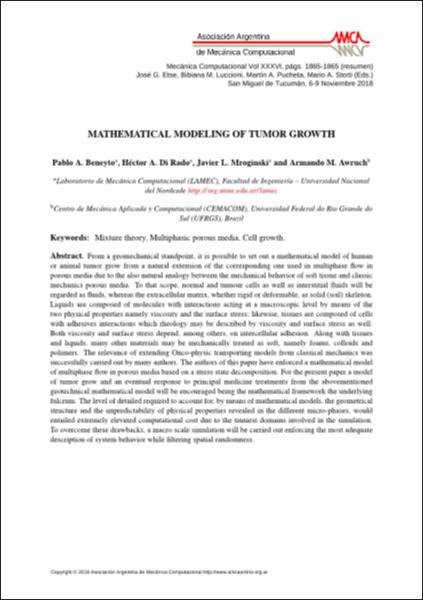Mostrar el registro sencillo del ítem
Mathematical modeling of tumor growth
| dc.contributor.author | Beneyto, Pablo Alejandro | |
| dc.contributor.author | Di Rado, Héctor Ariel | |
| dc.contributor.author | Mroginski, Javier Luis | |
| dc.contributor.author | Awruch, Armando Miguel | |
| dc.date.accessioned | 2023-06-13T15:55:13Z | |
| dc.date.available | 2023-06-13T15:55:13Z | |
| dc.date.issued | 2018 | |
| dc.identifier.citation | Beneyto, Pablo Alejandro, et al., 2017. Mathematical modeling of tumor growth. Mecánica Computacional. Santa Fe: Asociación Argentina de Mecánica Computacional, vol. 36, p. 1835-1835. ISSN 2591-3522. | es |
| dc.identifier.uri | http://repositorio.unne.edu.ar/handle/123456789/51676 | |
| dc.description.abstract | From a geomechanical standpoint, it is possible to set out a mathematical model of human or animal tumor grow from a natural extension of the corresponding one used in multiphase flow in porous media due to the also natural analogy between the mechanical behavior of soft tissue and classic mechanics porous media. To that scope, normal and tumour cells as well as interstitial fluids will be regarded as fluids, whereas the extracellular matrix, whether rigid or deformable, as solid (soil) skeleton. Liquids are composed of molecules with interactions acting at a macroscopic level by means of the two physical properties namely viscosity and the surface stress; likewise, tissues are composed of cells with adhesives interactions which rheology may be described by viscosity and surface stress as well. Both viscosity and surface stress depend, among others, on intercellular adhesion. Along with tissues and liquids, many other materials may be mechanically treated as soft, namely foams, colloids and polimers. The relevance of extending Onco-physic transporting models from classical mechanics was successfully carried out by many authors. The authors of this paper have enforced a mathematical model of multiphase flow in porous media based on a stress state decomposition. For the present paper a model of tumor grow and an eventual response to principal medicine treatments from the abovementioned geotechnical mathematical model will be encouraged being the mathematical framework the underlying fulcrum. The level of detailed required to account for, by means of mathematical models, the geometrical structure and the unpredictability of physical properties revealed in the different micro-phases, would entailed extremely elevated computational cost due to the tinniest domains involved in the simulation. To overcome these drawbacks, a macro scale simulation will be carried out enforcing the most adequate description of system behavior while filtering spatial randomness. Mecánica Computacional Vol XXXVI, págs. 1865-1865 (resumen) José G. Etse, Bibiana M. Luccioni, Martín A. Pucheta, Mario A. Storti (Eds.) San Miguel de Tucumán, 6-9 Noviembre 2018 Copyright | es |
| dc.format | application/pdf | es |
| dc.format.extent | p. 1865-1865 | es |
| dc.language.iso | eng | es |
| dc.publisher | Asociación Argentina de Mecánica Computacional | es |
| dc.rights | openAccess | es |
| dc.rights.uri | http://creativecommons.org/licenses/by-nc-nd/2.5/ar/ | es |
| dc.source | Mecánica Computacional, 2018, vol. 36, p. 1865-1865 | es |
| dc.subject | Mixture theory | es |
| dc.subject | Multiphasic porous media | es |
| dc.subject | Cell growth | es |
| dc.title | Mathematical modeling of tumor growth | es |
| dc.type | Artículo | es |
| unne.affiliation | Fil: Beneyto, Pablo Alejandro. Universidad Nacional del Nordeste. Facultad de Ingeniería; Argentina. | es |
| unne.affiliation | Fil: Di Rado, Héctor Ariel. Universidad Nacional del Nordeste. Facultad de Ingeniería; Argentina. | es |
| unne.affiliation | Fil: Mroginski, Javier Luis. Universidad Nacional del Nordeste. Facultad de Ingeniería; Argentina. | es |
| unne.affiliation | Fil: Awruch, Armando Miguel. Universidad Federal do Rio Grande do Sul. Centro de Mecánica Aplicada y Computacional; Brasil. | es |
| unne.journal.pais | Argentina | es |
| unne.journal.ciudad | Santa Fe | es |
| unne.journal.volume | 36 | es |
Ficheros en el ítem
Este ítem aparece en la(s) siguiente(s) colección(ones)
-
Artículos de revista [51]





